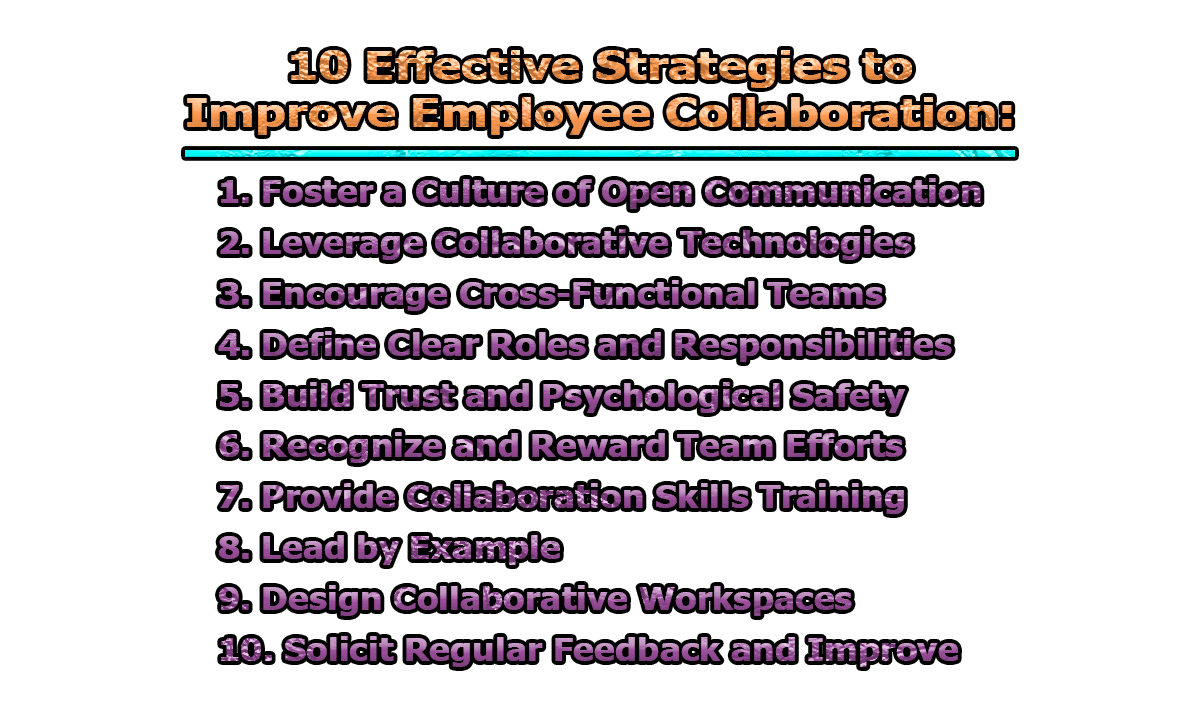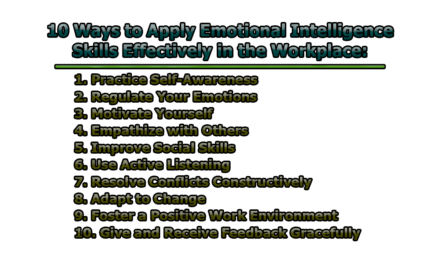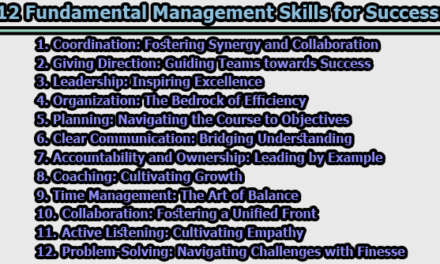10 Effective Strategies to Improve Employee Collaboration:
In today’s dynamic work environment, collaboration is more than just a corporate buzzword — it’s an essential driver of innovation, productivity, and employee satisfaction. When employees work well together, they share knowledge, solve problems faster, and build a workplace culture that thrives on mutual trust and support. Yet, fostering genuine collaboration doesn’t happen overnight; it requires intentional strategies, supportive leadership, and the right tools and culture. This article explores 10 effective strategies to improve employee collaboration.
1. Foster a Culture of Open Communication: Open communication is the heartbeat of effective collaboration. Without it, even the best strategies and tools will fall flat. Organizations that prioritize transparent communication help employees feel heard, valued, and comfortable sharing their perspectives — whether it’s a junior staff member suggesting a new idea or a senior manager asking for honest feedback.
One way to build this culture is by creating multiple channels for communication. This could include regular team huddles, open-door policies where managers make themselves available for impromptu chats, and anonymous suggestion boxes for employees who may feel shy about speaking up in groups. Companies like Google and Pixar are well-known for fostering such open dialogue, which encourages employees to question assumptions and challenge ideas in constructive ways (Edmondson, 1999).
Most importantly, leaders must model this openness themselves — they should listen actively, respond respectfully, and show that all voices matter, regardless of role or seniority. When communication flows freely, misunderstandings decrease, trust grows, and collaboration naturally strengthens (Gratton & Erickson, 2007).
2. Leverage Collaborative Technologies: In today’s increasingly remote and hybrid work environments, digital collaboration tools are the glue that holds teams together. Gone are the days when face-to-face meetings and endless email threads were enough. Modern teams rely on platforms like Microsoft Teams, Slack, Asana, or Trello to stay connected, share updates, assign tasks, and co-create documents in real time.
However, technology alone won’t fix poor collaboration. Organizations need to choose tools that truly fit their workflows and make it easy for everyone to participate. For example, cloud-based file sharing (like Google Drive or Dropbox) ensures that employees always have access to the latest documents — no more confusion over version control. Video conferencing platforms help distributed teams connect face-to-face, maintaining a sense of human connection that emails can’t replicate (Majchrzak et al., 2012).
The key is to offer training and clear guidelines on how to use these tools effectively. Otherwise, they risk becoming underused or adding to digital overload. When implemented thoughtfully, collaborative technologies bridge gaps across time zones, keep everyone aligned, and empower teams to work together seamlessly — whether they’re across the hall or across the world.
3. Encourage Cross-Functional Teams: Breaking down silos is one of the most powerful ways to spark creativity and innovation. Cross-functional teams — groups that bring together people from different departments and expertise — are designed to do exactly that. Instead of each department solving problems in isolation, these diverse teams tackle challenges collectively, often producing better solutions than any one group could on its own (Denning, 2011).
For example, when launching a new product, a cross-functional team might include engineers, marketers, designers, and customer support staff. Each person brings a unique perspective: engineers know what’s technically feasible, marketers understand customer needs, designers focus on user experience, and support staff offer insights into common customer pain points. Together, they can anticipate challenges, innovate faster, and deliver a product that’s more likely to succeed.
However, for cross-functional collaboration to work well, organizations must create an environment where different departments trust each other and share information freely. Clear goals, defined roles, and skilled facilitators help keep these teams aligned and focused. Done right, cross-functional collaboration doesn’t just solve immediate problems — it builds lasting connections across the organization and makes knowledge sharing the norm rather than the exception.
4. Define Clear Roles and Responsibilities: One of the most overlooked barriers to effective collaboration is role confusion. When people don’t know exactly what’s expected of them — or how their work connects to their teammates’ work — frustration and conflict can easily take root. Clear roles and responsibilities help everyone understand who does what, who makes which decisions, and how tasks flow across the team (Hackman, 2002).
For instance, in a project team, you might have a project manager who sets deadlines and coordinates meetings, a lead designer who owns the user interface, and a quality assurance specialist who signs off on testing. If those lines get blurred — say, two people assume they’re both in charge of approvals — deadlines slip, accountability fades, and trust can erode.
A simple but powerful tool is a RACI matrix — it clarifies who is Responsible, Accountable, Consulted, and Informed for each task. This helps teams align expectations upfront and minimizes misunderstandings later. Ultimately, when people have clarity about their own role and trust that teammates are equally clear about theirs, collaboration becomes smoother and far more productive (Hackman, 2002).
5. Build Trust and Psychological Safety: Trust isn’t just a warm and fuzzy concept — it’s the foundation for teams to share ideas openly, take risks, and learn from mistakes without fear of blame. Amy Edmondson’s influential research coined the term psychological safety to describe this climate of mutual respect and openness (Edmondson, 1999). Teams with high psychological safety don’t punish people for asking questions or admitting they don’t know something; instead, they encourage curiosity and experimentation (Edmondson & Lei, 2014).
Building trust starts with leaders showing vulnerability and humility — admitting when they’re unsure, listening actively, and encouraging input from everyone, not just the loudest voices. Simple practices like rotating who leads meetings or asking quieter team members for their perspectives can make a huge difference.
When people trust their team, they’re more likely to speak up with new ideas, share honest feedback, and collaborate on tough challenges. This doesn’t just make people feel good — it improves performance. Research consistently shows that teams with strong trust and psychological safety learn faster and adapt better in dynamic environments (Carmeli et al., 2009; Edmondson & Lei, 2014).
6. Recognize and Reward Team Efforts: Nothing kills motivation to collaborate faster than seeing only individual achievements being celebrated. If collaboration is the goal, then teams need to see that working together actually pays off. Recognition doesn’t always have to be monetary — public praise, shout-outs in meetings, or team lunches can reinforce that the organization values shared success (Grant & Parker, 2009).
For example, some companies build recognition into their culture through peer-nominated awards for teamwork or by tying bonuses partly to team performance. When people know their collaborative contributions are seen and appreciated, they’re more likely to keep sharing ideas, helping colleagues, and investing in collective outcomes.
Importantly, recognition should highlight how teams worked together — not just what they delivered. Did they resolve conflicts well? Did they support each other under pressure? Did they share knowledge openly? Celebrating these behaviors helps reinforce the collaborative mindset and shows everyone that “we” matters just as much as “me” (Grant & Parker, 2009).
7. Provide Collaboration Skills Training: While some people seem naturally gifted at teamwork, most employees benefit greatly from intentional training to strengthen their collaboration skills. Many conflicts, misunderstandings, or stalled projects can be traced back not to a lack of effort, but to gaps in key interpersonal skills like active listening, conflict resolution, and giving constructive feedback (Wheelan, 2005).
For example, team members who know how to listen deeply are better able to understand different perspectives and find common ground during disagreements. Training can also equip people with techniques to handle difficult conversations without letting emotions derail progress. Workshops, role-playing scenarios, or even simple lunchtime learning sessions can help employees practice these skills in a safe, supportive setting.
Organizations that invest in soft-skills development often see tangible benefits: fewer conflicts, faster problem-solving, and more resilient teams that can adapt to changing conditions (Goleman et al., 2013). Training shouldn’t be a one-off event — making it a regular part of professional development signals that collaboration is a core competency, just like technical skills.
8. Lead by Example: No collaboration strategy will stick if leadership doesn’t walk the talk. Leaders at all levels — from team supervisors to senior executives — have an outsized influence on how collaboration is perceived and practiced across the organization. If managers hoard information, dismiss input, or reward individual heroics over team results, employees quickly pick up on these mixed signals (Goleman et al., 2013).
By contrast, when leaders model collaborative behaviors — like sharing credit, seeking diverse opinions, and working alongside their teams to solve problems — they set a powerful tone. Employees learn that it’s safe and worthwhile to speak up, share ideas, and pitch in beyond their job description.
One practical approach is for leaders to hold regular cross-departmental meetings, participate in brainstorming sessions as equals, and openly admit when they don’t have all the answers. This humility and openness foster trust and encourage others to contribute freely (Edmondson & Lei, 2014). In essence, leaders who champion collaboration by example make it clear that working together isn’t just encouraged — it’s expected and celebrated.
9. Design Collaborative Workspaces: Physical (and virtual) environments can either encourage teamwork or stifle it. A well-designed collaborative workspace makes it easy for employees to connect, share ideas spontaneously, and work together without barriers. Think open floor plans with breakout areas, cozy meeting pods for small group discussions, and whiteboards or digital displays that invite brainstorming on the fly (Stryker & Santoro, 2012).
Of course, open spaces alone don’t guarantee collaboration — they need to be balanced with quiet zones where people can focus without distraction. In the hybrid or remote work era, this principle extends to digital spaces too. Virtual collaboration rooms, shared digital whiteboards (like Miro or Mural), and informal chat channels replicate the “watercooler effect,” helping people connect organically even when they’re not co-located (Majchrzak et al., 2012).
Organizations should also involve employees in designing these spaces. Asking teams what they need to collaborate better — more meeting rooms? Better video conferencing tech? Flexible seating? — ensures that the environment truly supports how people work together. When the physical and virtual spaces match the team’s collaborative style, innovation and communication flow much more naturally.
10. Solicit Regular Feedback and Improve: Even with the best collaboration tools, training, and leadership, no organization gets collaboration perfectly right the first time — and that’s okay. The most effective teams treat collaboration as a living system that evolves with their needs. To do this well, organizations must build feedback loops into their everyday work so they can identify obstacles and adjust practices in real time (Carmeli et al., 2009).
For example, regular check-ins, project retrospectives, or simple “pulse surveys” can help leaders gauge what’s helping teams work well together — and what’s holding them back. If employees feel bogged down by too many meetings, unclear communication channels, or clunky tools, they’re more likely to say so when they know their feedback will be heard and acted on.
But collecting feedback isn’t enough — it has to lead to visible change. When employees see that their input results in better workflows, improved policies, or new tools that make teamwork easier, they’re far more likely to keep sharing honest insights. Over time, this creates a culture of continuous improvement, where collaboration strengthens naturally instead of being forced (Edmondson, 1999).
In fast-changing work environments, this adaptability can be a team’s greatest asset. Organizations that stay open to learning and iterating on how they collaborate will always be better equipped to meet new challenges together.
In conclusion, effective collaboration doesn’t happen by accident; it’s the result of deliberate strategies, strong leadership, and a culture that values openness and trust. By implementing these ten strategies, organizations can break down silos, spark innovation, and empower their teams to achieve more together than they ever could alone. In an era where teamwork often determines success, investing in collaboration is one of the smartest moves any organization can make.
Frequently Asked Questions (FAQs):
Why is employee collaboration so important today?
Collaboration is critical because modern workplace challenges are too complex for one person or department to handle alone. When people share ideas, skills, and perspectives, they solve problems faster, create better solutions, and build a culture of trust and support. Strong collaboration also helps teams adapt to change and keeps employees motivated.
What are the biggest barriers to good collaboration?
The most common roadblocks include poor communication, unclear roles, lack of trust, teams working in silos, outdated tools, or leaders who don’t practice what they preach. Sometimes people also just don’t know how to work well with others — they may need help developing skills like listening and resolving conflicts.
How can leaders know if collaboration efforts are working?
One of the best ways is to ask employees directly through surveys, regular check-ins, or quick team feedback sessions. It’s also smart to watch for signs like how well cross-team projects go, whether people freely share ideas, and if the overall team spirit feels positive and supportive.
Does using technology automatically improve collaboration?
Not by itself. Tools like messaging apps, project boards, or video meetings can help people stay connected, but they can’t fix problems like mistrust or poor communication on their own. Good collaboration starts with people — technology should simply make it easier for everyone to stay in sync.
What’s an example of a healthy collaborative environment?
A good example is a team where people feel comfortable asking questions, raising concerns, or admitting they need help — and no one gets blamed or ignored for speaking up. When people feel safe to share honestly, teams catch mistakes sooner, learn faster, and work better together.
How often should teamwork or collaboration training happen?
Ideally, it shouldn’t be a one-time workshop. Short training sessions, practice activities, or team-building exercises should be part of an ongoing learning plan. Many companies make collaboration skills part of onboarding and refresh them throughout the year to keep skills sharp.
Can remote teams collaborate as well as in-person teams?
Definitely — but it takes effort. Remote teams need clear ways to communicate, the right digital tools, and good habits for staying connected. Things like regular video check-ins, virtual brainstorming, and even online coffee chats help keep people feeling part of the team.
How do you encourage departments to work together when silos are strong?
Start small. Create projects that require people from different areas to team up and solve a shared problem. Give these teams clear goals and celebrate early wins. Leaders should also set the tone by encouraging departments to share knowledge instead of guarding it.
What’s one quick thing a manager can do to boost collaboration tomorrow?
Listen! Ask your team what’s blocking them from working well together and what support they need. Also, notice and recognize examples of good teamwork, however small — whether it’s someone helping a coworker or sharing information that benefits everyone.
What’s the biggest mistake companies make when trying to improve collaboration?
One common mistake is assuming collaboration will “just happen” if people have the right tools or sit in the same room. In reality, teams need clear roles, trust, supportive leaders, and a safe culture where everyone feels encouraged to speak up and pitch in.
References:
- Carmeli, A., Brueller, D., & Dutton, J. E. (2009). Learning behaviours in the workplace: The role of high-quality interpersonal relationships and psychological safety. Systems Research and Behavioral Science, 26(1), 81–98. https://doi.org/10.1002/sres.932
- Denning, S. (2011). The leader’s guide to radical management: Reinventing the workplace for the 21st century. Jossey-Bass.
- Edmondson, A. (1999). Psychological safety and learning behavior in work teams. Administrative Science Quarterly, 44(2), 350–383. https://doi.org/10.2307/2666999
- Edmondson, A. C., & Lei, Z. (2014). Psychological safety: The history, renaissance, and future of an interpersonal construct. Annual Review of Organizational Psychology and Organizational Behavior, 1, 23–43. https://doi.org/10.1146/annurev-orgpsych-031413-091305
- Goleman, D., Boyatzis, R., & McKee, A. (2013). Primal leadership: Unleashing the power of emotional intelligence (10th anniversary ed.). Harvard Business Review Press.
- Grant, A. M., & Parker, S. K. (2009). Redesigning work design theories: The rise of relational and proactive perspectives. Academy of Management Annals, 3(1), 317–375. https://doi.org/10.5465/19416520903047327
- Gratton, L., & Erickson, T. J. (2007). Eight ways to build collaborative teams. Harvard Business Review, 85(11), 100–109. https://hbr.org/2007/11/eight-ways-to-build-collaborative-teams
- Hackman, J. R. (2002). Leading teams: Setting the stage for great performances. Harvard Business Press.
- Majchrzak, A., More, P. H. B., & Faraj, S. (2012). Transcending knowledge differences in cross-functional teams. Organization Science, 23(4), 951–970. https://doi.org/10.1287/orsc.1110.0677
- Stryker, J. B., & Santoro, M. D. (2012, January 1). Facilitating face-to-face communication in high-tech teams: Face-to-face communication is a necessary component of team collaboration; the physical design of the space, including the visibility of workstations and the availability of community spaces, can affect the level of face-to-face communication. The Free Library. Retrieved From: https://www.thefreelibrary.com/Facilitating+face-to-face+communication+in+high-tech+teams%3A…-a0277519137
- Wheelan, S. A. (2005). Creating effective teams: A guide for members and leaders (2nd ed.). SAGE Publications.

Library Lecturer at Nurul Amin Degree College










